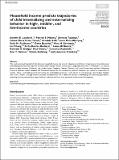| dc.contributor.author | Jennifer E Lansford, Patrick S Malone, Sombat Tapanya, Liliana Maria Uribe Tirado, Arnaldo Zelli, Liane Peña Alampay, Suha M Al-Hassan, Dario Bacchini, Marc H Bornstein, Lei Chang, Kirby Deater-Deckard, Laura Di Giunta, Kenneth A Dodge, Paul Oburu, Concetta Pastorelli, Ann T Skinner, Emma Sorbring, Laurence Steinberg | |
| dc.date.accessioned | 2020-08-04T08:33:51Z | |
| dc.date.available | 2020-08-04T08:33:51Z | |
| dc.date.issued | 2019-01 | |
| dc.identifier.uri | https://repository.maseno.ac.ke/handle/123456789/1794 | |
| dc.description | The article can also be accessed via;https://journals.sagepub.com | en_US |
| dc.description.abstract | This study examined longitudinal links between household income and parents’ education and children’s trajectories of internalizing and externalizing behaviors from age 8 to 10 reported by mothers, fathers, and children. Longitudinal data from 1,190 families in 11 cultural groups in eight countries (Colombia, Italy, Jordan, Kenya, Philippines, Sweden, Thailand, and United States) were included. Multigroup structural equation models revealed that household income, but not maternal or paternal education, was related to trajectories of mother-, father-, and child-reported internalizing and externalizing problems in each of the 11 cultural groups. Our findings highlight that in low-, middle-, and high-income countries, socioeconomic risk is related to children’s internalizing and externalizing problems, extending the international focus beyond children’s physical health to their emotional and behavioral development. | en_US |
| dc.publisher | Sage Publications | en_US |
| dc.subject | Child internalizing and externalizing behavior, income, international, parental education, socioeconomic status | en_US |
| dc.title | Household income predicts trajectories of child internalizing and externalizing behavior in high-, middle-, and low-income countries | en_US |
| dc.type | Article | en_US |

